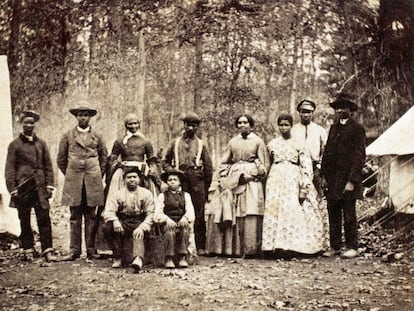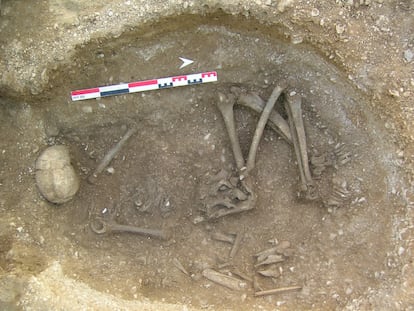The male sex chromosome, the last unexplored territory of human DNA, has been conquered
An international consortium managed to read the previously elusive Y chromosome, which is crucial in determining sex in men and linked to an increased risk of cancer

A person’s DNA constitutes a recipe book for the proteins that are essential for life, such as myosin for the muscles and hemoglobin to carry oxygen in the blood. Now, an international consortium of scientists has just announced that it finally managed to read the last blurred page of that book: the hitherto indecipherable Y chromosome, which is involved in determining the male sex and in the production of spermatozoa, but also, when something goes wrong, in serious diseases like cancer. The breakthrough, the result of more than 30 years of work, was published this Wednesday in the journal Nature.
The challenge was massive. With the current technology, it is not possible to read a person’s entire DNA (their genome) in one go, so researchers have to decipher millions of tiny jumbled fragments and then put them together. It is like reconstructing a text of more than 3,000 million letters from a series of shuffled sentences and paragraphs. The Y chromosome only has 62 million letters (2% of the total), but the difficulty level was tremendous because its structure is very confusing, riddled with repeated sections. To give an example, if the genome were the song American Pie, it would be easy to reorganize its chorus based on its misplaced fragments: “Miss American pie,” “bye bye,” “but the levee was dry,” “drove my Chevy to the levee.” However, it would be much more cumbersome to learn that this chorus appears seven times throughout the song, or to guess the repetition in “This’ll be the day that I die, this’ll be the day that I die.”
A person’s DNA is present in each of their cells, grouped into 46 packages — the chromosomes — which are structures shaped like a hank of yarn. Two of the chromosomes, X and Y, determine sex. Most women have two X chromosomes; in men, it is common to have one X and one Y. The Y chromosome contains the genetic information that causes the male genitalia to develop in the embryo, but it also has other essential roles. Men who lack a Y chromosome in some of their cells (due to causes such as tobacco addiction and aging) are at increased risk of cancer, Alzheimer’s and heart disease.
The consortium, named T2T and led by the U.S. National Institutes of Health, had already published last year the first complete human genome, letter by letter, but the entire enigmatic male sex chromosome had yet to be read. It was “the last unexplored territory of human DNA,” according to biologist Tomàs Marquès Bonet from the Institute of Evolutionary Biology in Barcelona.
Amazing variability
Another international team of scientists, the Human Genome Structural Variation Consortium, published this Wednesday the almost complete sequences of another 43 Y chromosomes of people from different parts of the world, showing an astonishing variability. There are men with 45 million letters on their Y chromosome, while others are close to 85 million. “This is especially important for biomedical research, since the structural variants of the Y are at the root of many traits and diseases,” explains Marquès Bonet, who did not participate in this research.
Biologist Bernardo Rodríguez explains that half of the Y chromosome had been resisting for decades. “The half that is highly repetitive was missing. If it were a puzzle with the picture of a landscape, it would have been the pieces forming the blue sky,” says Rodríguez, from the European Molecular Biology Laboratory, in Heidelberg, Germany. The T2T consortium estimates that the human genome has about 20,000 genes (short segments of DNA), each with its own recipe for making proteins, but only 106 of them are in the Y chromosome. One is the SRY gene, known as the “male-determining gene” because it causes the testicles to form in the embryo.

Rodríguez points out that the existence of 41 of these Y chromosome genes was unknown. “Now we have to see what role they play. In addition, these missing regions are turning out to be the most variable in the genome, because, being very repetitive, they change a lot from one individual to another,” explains the researcher, a member of the Human Genome Structural Variation Consortium. “Accessing the Y chromosome can lead to the discovery of new variants associated with diseases, including cancer,” he says. Geneticist Karen Miga, co-director of the T2T consortium and researcher at the University of California, Santa Cruz, said in a statement that their goal is to make the data available to the international scientific community.
Half of men will suffer a malignant tumor before the age of 85, compared to just a third of women, according to the Spanish Society of Medical Oncology. The greater male susceptibility to tumors is explained by the higher consumption of tobacco and alcohol, but also by biological intricacies such as the loss of genetic material from the Y chromosome that happens throughout life, as shown in 2020 by the team of bioinformatician Juan Ramón Gonzalez. “This study opens up new perspectives to understand how the loss of the Y chromosome is associated with a higher incidence of certain diseases and mortality in men,” says González, from the Barcelona Institute for Global Health.
Genomic science picks up speed
Technological advances made the conquest of the Y chromosome possible. The machines of the British company Oxford Nanopore now allow millions of consecutive letters to be read, with errors that are corrected with the American tool PacBio, achieving an accurate reading of sections of more than 20,000 letters. González applauds that there is finally a reference sequence for the Y chromosome: “The main advantage of this study lies in its applicability, as it enables the efficient analysis of millions of genomes from different populations,” he celebrates.
The bioinformatician emphasizes that this work could also be crucial in forensic medicine and human evolution research, as a man inherits the Y chromosome from his father, who inherited it from his father, forming a direct line. A man’s male sex chromosome will be virtually identical to that of his brothers and other paternal relatives. That information is very useful, both for identifying a serial killer by his DNA and for tracking migrations over the centuries.
The current reference genome, called GRCh38, is a mosaic of genetic information, of which 70% comes from a man who volunteered in 1997 for the Human Genome Project in the United States after reading an advertisement in The Buffalo News. The first draft was presented in 2001 to great fanfare, despite being very incomplete, and since then the scientific community has used it to search for genetic variants associated with diseases.
The T2T consortium has now completed its version: the truly complete sequence of a human genome, named CHM13, now including the Y chromosome. However, the ancestors of this genome are mostly European, so another international consortium is finalizing a pangenome that it will include 350 complete genomes from all around the world to reflect the genetic diversity of humans.
Sign up for our weekly newsletter to get more English-language news coverage from EL PAÍS USA Edition
Tu suscripción se está usando en otro dispositivo
¿Quieres añadir otro usuario a tu suscripción?
Si continúas leyendo en este dispositivo, no se podrá leer en el otro.
FlechaTu suscripción se está usando en otro dispositivo y solo puedes acceder a EL PAÍS desde un dispositivo a la vez.
Si quieres compartir tu cuenta, cambia tu suscripción a la modalidad Premium, así podrás añadir otro usuario. Cada uno accederá con su propia cuenta de email, lo que os permitirá personalizar vuestra experiencia en EL PAÍS.
¿Tienes una suscripción de empresa? Accede aquí para contratar más cuentas.
En el caso de no saber quién está usando tu cuenta, te recomendamos cambiar tu contraseña aquí.
Si decides continuar compartiendo tu cuenta, este mensaje se mostrará en tu dispositivo y en el de la otra persona que está usando tu cuenta de forma indefinida, afectando a tu experiencia de lectura. Puedes consultar aquí los términos y condiciones de la suscripción digital.
More information
Archived In
Últimas noticias
Petro claims the ELN was the target of US attack in Venezuela
Maduro counterattacks Trump with rhetoric and announces downing of nine drug trafficking aircraft
‘Ecce Homo’: The miraculous disaster that made a small Spanish town famous
Return to sex testing at the Olympics: IOC edges closer to banning transgender women
Most viewed
- Sinaloa Cartel war is taking its toll on Los Chapitos
- Oona Chaplin: ‘I told James Cameron that I was living in a treehouse and starting a permaculture project with a friend’
- Reinhard Genzel, Nobel laureate in physics: ‘One-minute videos will never give you the truth’
- Why the price of coffee has skyrocketed: from Brazilian plantations to specialty coffee houses
- Silver prices are going crazy: This is what’s fueling the rally











































